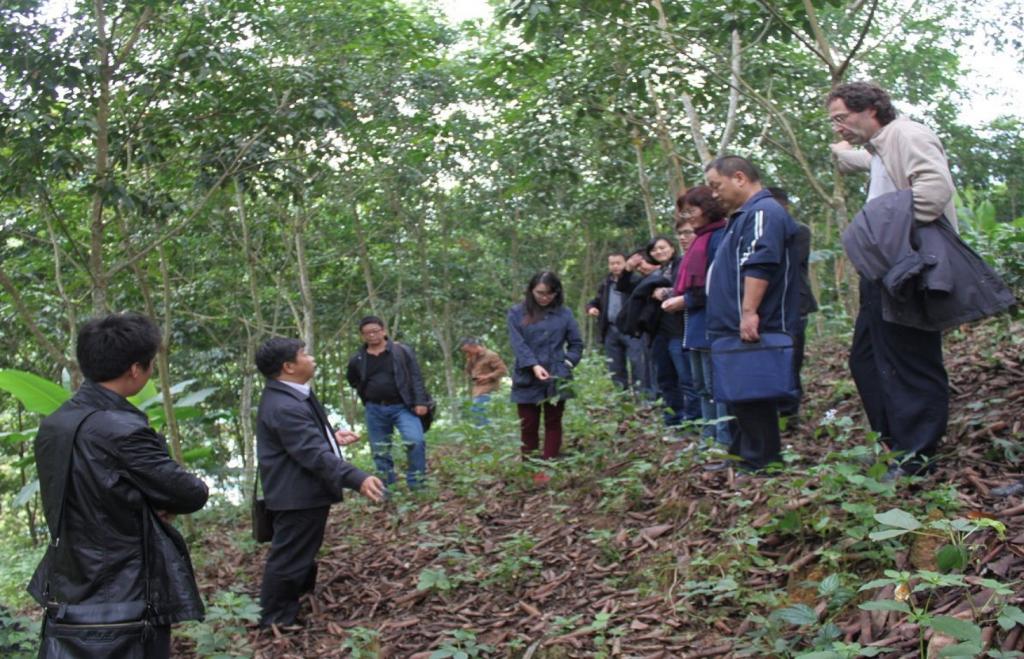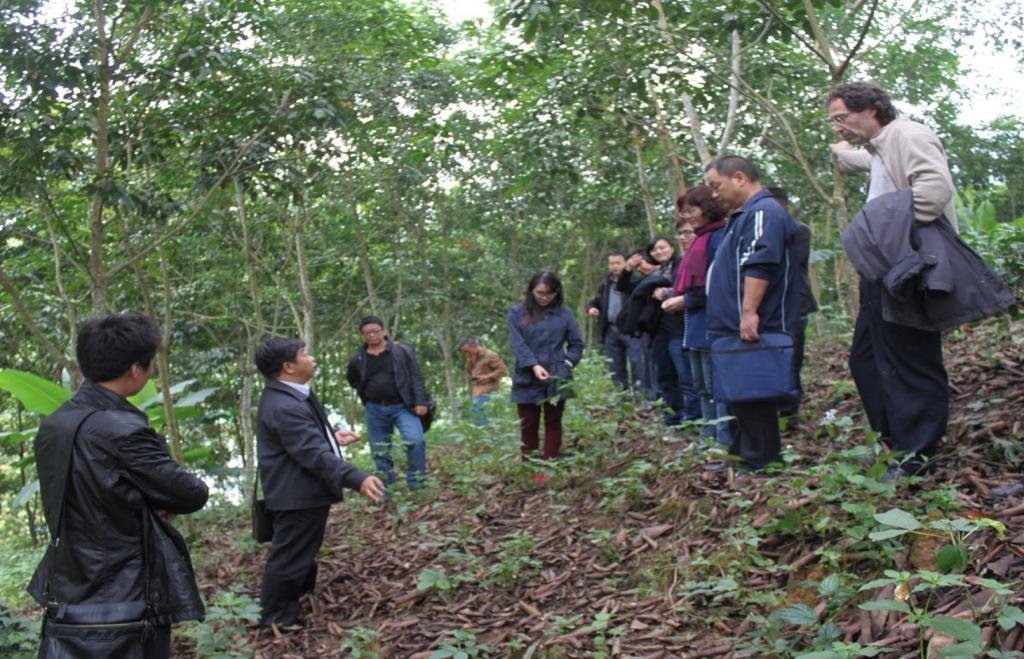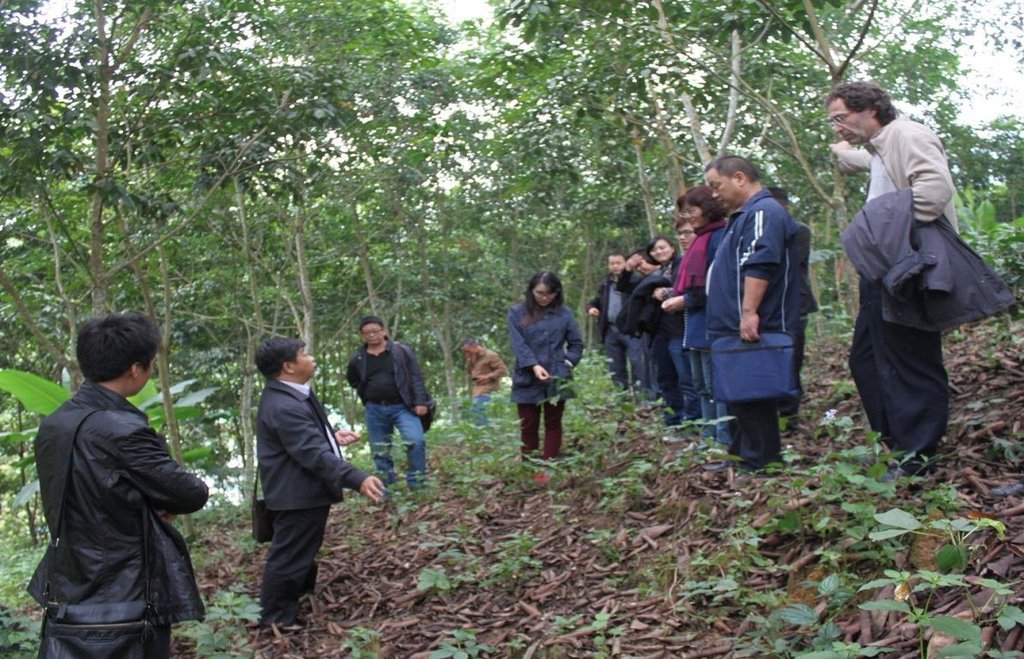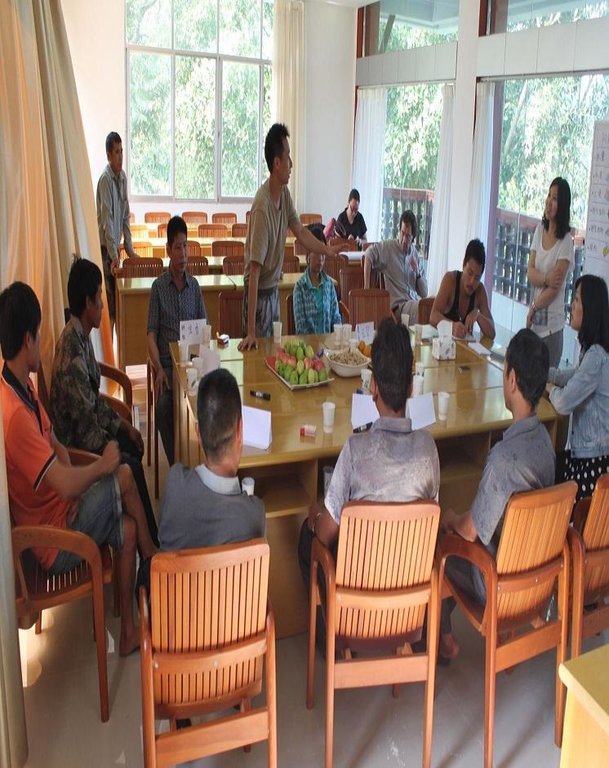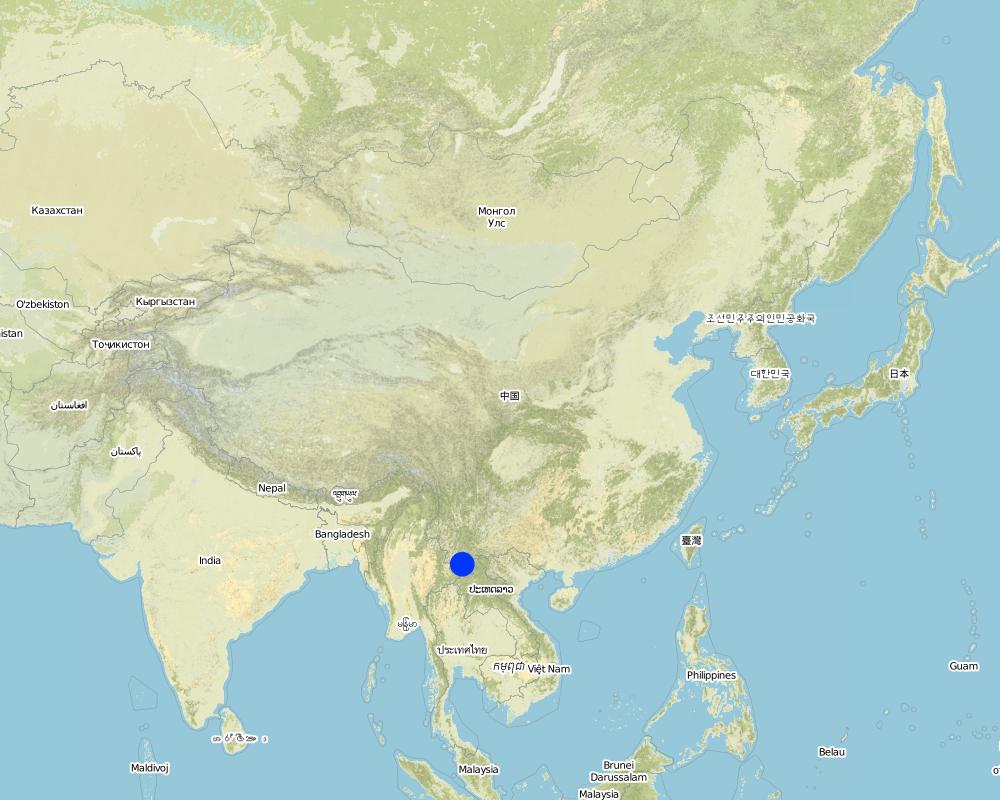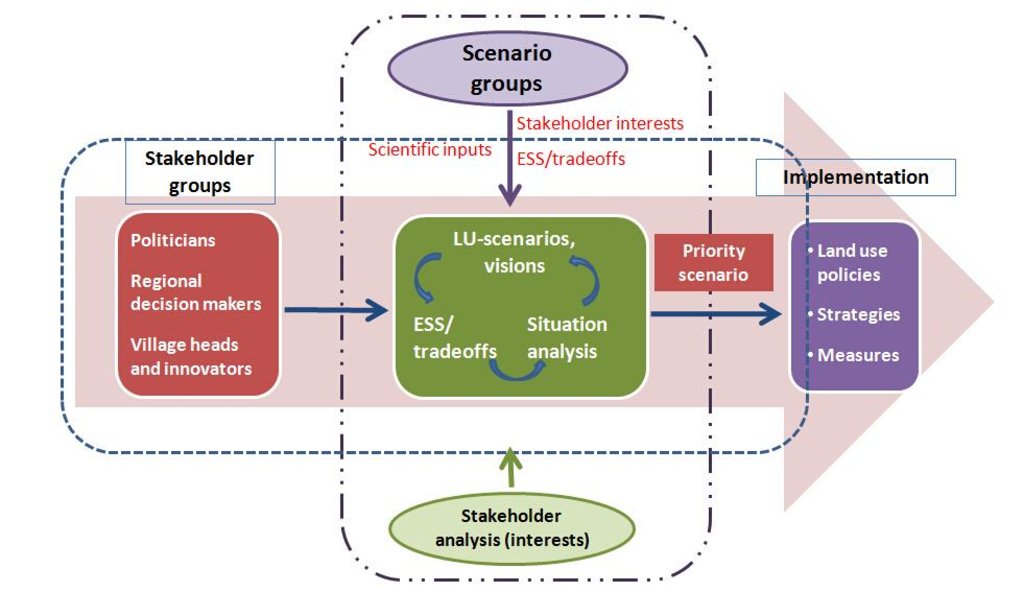Scientist-practitioner communication for sustainable rubber cultivation in China [中国]
- 创建:
- 更新:
- 编制者: Thomas Aenis
- 编辑者: –
- 审查者: David Streiff, Deborah Niggli
approaches_2618 - 中国
查看章节
全部展开 全部收起1. 一般信息
1.2 参与方法评估和文件编制的资源人员和机构的联系方式
有助于对方法进行记录/评估的项目名称(如相关)
Book project: Making sense of research for sustainable land management (GLUES)有助于对方法进行记录/评估的机构名称(如相关)
Universität Hohenheim - 德国有助于对方法进行记录/评估的机构名称(如相关)
Humboldt Universität zu Berlin (HU Berlin) - 德国有助于对方法进行记录/评估的机构名称(如相关)
China Agricultural University (China Agricultural University) - 中国1.3 关于使用通过WOCAT记录的数据的条件
(现场)数据是什么时候汇编的?:
27/01/2016
编制者和关键资源人员接受有关使用通过WOCAT记录数据的条件。:
是
2. SLM方法的描述
2.1 该方法的简要说明
Establishing communication between scientists and practitioners to improve sustainable rubber cultivation in Yunnan, China
2.2 该方法的详细说明
该方法的详细说明:
Aims / objectives: The Sino-German project “SURUMER: Sustainable rubber cultivation in the Mekong Region” is identifying appropriate, stakeholder-validated concepts for sustainable rubber cultivation in Xishuangbanna prefecture, South-west China. In order to at least begin to implement solutions for problems arising from monoculture, project partners from five German and seven Chinese research institutes and practitioner partners are testing a holistic approach. This combines communication activities (bilateral, as well as groups, mainly through workshops) with scientific analysis to enhance interaction and collaborative learning between practitioners and researchers.
Methods: The approach comprises a pragmatic combination of discourse instruments such as direct communication amongst partners, bilingual information material, newsletters, focus groups, and a series of workshops with key stakeholders. One of its main elements is participatory scenario development - including discussions on problem situations, priorities regarding ecosystem services, and trade-offs in different land use strategies.
Stages of implementation: During the first three-year phase of research, ecosystem functions and services were assessed and quantified. This phase of situation analysis had a clear multidisciplinary focus amongst researchers (topics as widely varied as carbon sequestration, pollination, and household economy). The next phase attempted to integrate findings from on-site measurements, household surveys, policy analyses and joint problem solving into identifying new land management options. A modelling approach which uses assessment indicators to define impacts of land management was chosen. The model also identifies trade-offs and synergies in different land management options. During this phase, demonstration trials were established at the plot level. In the last phase, the focus has shifted more and more towards implementation activities, for example policy briefings and training for farmers, village heads and administrative staff. Discussions with key actors amongst the practitioners, who can influence implementation, have started as early as possible. This follows the assumption that the more “realistic” the concepts are, and the better they are communicated to, and discussed with, the stakeholders, the greater the likelihood of implementation.
Role of stakeholders: Apart from the scientists, three key stakeholder groups have been identified, namely rubber farmers (often the village heads), regional decision-makers (prefecture administration and rubber companies), and provincial politicians. The main initiative, as well as the process of moderation, came from the group of scientists. Practitioners participate regularly at workshops and meetings. They express their interests regarding future rubber cultivation, and the information they would like to get from the researchers, and how this should be communicated.
Other important information: Experience shows that communication processes initiated by research play a key role and must be managed carefully. It is clear that significant resources and long-term commitment are needed, and that even “long” research projects of five years are not sufficient to reach full implementation or create impact.
2.3 该方法的照片
2.5 采用该方法的国家/地区/地点
国家:
中国
区域/州/省:
Yunnan
有关地点的进一步说明:
Xishuangbanna
Map
×2.6 该方法的开始和终止日期
注明开始年份:
2012
终止年份(若不再采用该方法):
2016
2.7 方法的类型
- 基于项目/方案
2.8 该方法的主要目的/目标
The Approach focused mainly on SLM with other activities (Joint situation analysis, land use objectives/scenarios, networking (scientists & practitioners))
The holistic approach towards research-practice-integration combines scientific analyses with a range of activities to enhance interaction and collaborative learning amongst practitioners and researchers. This fosters the development of sustainable land use practices – amongst others the related technology: “Mitigating negative impacts of rubber monocultures by integrating native trees and changed weed management – and policies” (with an emphasis on sustainable rubber cultivation), and a start to implementation of project research results.
The SLM Approach addressed the following problems: In Xishuangbanna, Southwest China, monocultivation of rubber (Hevea brasiliensis) has enhanced farmers’ livelihoods fundamentally - but also caused severe environmental and societal problems. In order to sustain land use, a high standard of interdisciplinary integration as well as transdisciplinary communication and cooperation between researchers, practitioners and policy/administration is required this is to (at least partially) implement solutions to the complex problems related to sustainable land management. The more heterogeneous the actors are, the more challenging is the process of effective communication. However, commonly, neither procedures nor channels are established for such communication.
2.9 推动或妨碍实施本办法所适用的技术的条件
社会/文化/宗教规范和价值观
- 阻碍
Local stakeholders are not well aware of the linkage between rubber monoculture and environmental degradation, and that the high profitability of rubber encourages this monoculture.
Treatment through the SLM Approach: Through a small exhibition, focus group discussions, workshops and meetings, the research results and scientific findings have been presented to local stakeholders in order to raise awareness.
机构设置
- 阻碍
Under the framework conditions of rural China with its strong social hierarchy, decision-making is top-down. Farmers are very dependent on the government. Participation in regional land use planning is not an established concept, and local people are hesitant to actively demand change. They seldom try out innovations such as intercropping or reduced use of agro-chemicals by themselves: rather they accept government-led innovations - if they are subsidised.
Treatment through the SLM Approach: Changing farmers’ perceptions of technologies through ongoing communication: bilateral communication, focus group discussions and workshops. Awareness building about the problem and general approach: Training on “responsible use of agro-chemicals”. Demonstration plots could serve for monitoring of effects and as the location for future field schools.
法律框架(土地使用权、土地和水使用权)
- 阻碍
Farmers might not want to invest in trees because of limited duration of the land rights (maximum 50 to 70 years of usufruct right only), and rented land (usually 10-year contracts).
Treatment through the SLM Approach: No (ongoing discussion external to the project).
The existing land ownership, land use rights / water rights moderately hindered the approach implementation Water management and land use management always involves different stakeholders along the river or in the area, with complex ownership or user rights. Under the framework condition in rural China, it is difficult to involve different stakeholders and set-up a stakeholder dialogue, especially with those who have conflicting interests.
工作量、人力资源可用性
- 阻碍
Practitioners in the SURUMER research project are not convinced by the importance and necessity of stakeholder dialogue.
Treatment through the SLM Approach: Internal communication during plenary workshops, etc., to achieve agreement on stakeholder involvement and the role and responsibility of scientist in the stakeholder dialogue.
3. 相关利益相关者的参与和角色
3.1 该方法涉及的利益相关者及其职责
- 当地土地使用者/当地社区
Village heads as representatives, farmers
Poor farmers involved during baseline survey, using semi-structured interviews.
- SLM专家/农业顾问
Experts from Xishuangbanna Tropical Botanic Garden and Yunnan Institute of Tropical Crops
- 地方政府
Regional administrative, research institutes, company
- 国家政府(规划者、决策者)
Prefecture
Regional administratives such as people from Xishuangbanna Agricultural Bureau, Bio-industry Development office, Xishuangbanna Environmental Protection Bureau, Xishuangbanna Reclamation Bureau, Xishuangbanna Forest Bureau, and Naban River Watershed National Nature Reserve Bureau
- 国际组织
SURUMER project
3.2 当地土地使用者/当地社区参与该方法的不同阶段
| 当地土地使用者/当地社区的参与 | 指定参与人员并描述活动 | |
|---|---|---|
| 启动/动机 | 无 | |
| 计划 | 被动 | Approach and Technology planned by German and Chinese scientists with local partners: most important the Naban River Watershed National Nature Reserve Bureau. Mainly by informal communication, meetings and planning workshops. |
| 实施 | 互动 | German and Chinese researchers cooperated in organizing stakeholder workshops and presenting preliminary research results . Three groups of stakeholders (politicians, regional decision makers, and village heads) were actively involved through interviews, focus groups, etc. Nature reserve administration operates demonstration plots, supervised by German scientists, who are also responsible for performance monitoring. |
| 监测/评估 | 被动 | Stakeholders who participated in the dialogue are asked to give feedback and to evaluate the approach. The approach was also evaluated by an external team of experts. |
| Research | 被动 | Land users were the main source of information for stakeholder analysis, economic studies, and a study on willingness to accept changes. Results of research were fed back into the approach. For example by presenting the concept and preliminary results of the technique (e.g. integrating native trees) in the framework of stakeholder workshops in which further management options (e.g. reduced use of agro-chemicals) were discussed. |
3.3 流程图(如可用)
具体说明:
The discourses with the three stakeholder groups are focused on a joint situation analysis, discussion on the future of rubber, and discussion about ecosystem services and functions under different scenarios. Land use options are developed jointly and consequences concerning local policies, cultivation measures and market strategies are then discussed. Stakeholder discourses are linked with integrated scenario assessment and modelling by an interdisciplinary group of scientists.
作者:
Aenis, Thomas
3.4 有关SLM技术选择的决策
具体说明谁有权决定选择要实施的技术:
- 主要是SLM专家,咨询土地使用者之后
解释:
Considering the problems and interests of land users, specialists developed certain technologies. These were discussed and approved by land users.
Decisions on the method of implementing the SLM Technology were made by mainly by SLM specialists with consultation of land users. The original idea was developped by the researchers and valuated by local partners. After implementation, feedback from the participants led to an improvement of the approach. For an example, practitioners demanded preliminary results which then was discussed in the frame of the workshops.
4. 技术支持、能力建设和知识管理
4.1 能力建设/培训
是否为土地使用者/其他利益相关者提供培训?:
是
明确受训人员:
- 土地使用者
- 现场工作人员/顾问
培训形式:
- 农民对农民
- 示范区域
- 公开会议
- 课程
涵盖的主题:
Training focused (a) on agro-chemicals: problems, awareness, treatment; (b) on water protection: awareness, treatment; (c) on intercropping: demonstration
4.2 咨询服务
土地使用者有权使用咨询服务吗?:
是
指明是否提供了咨询服务:
- 在土地使用者的土地上
说明/注释:
the nature reserve administration organized the training and operates the demonstration field.
4.3 机构强化(组织发展)
是否通过这种方法建立或加强了机构?:
- 否
4.4 监测和评估
监测和评估是该方法的一部分吗?:
是
注释:
no. of land users involved aspects were regular monitored by project staff through observations; indicators: None
management of Approach aspects were regular monitored by project staff through observations; indicators: None
There were few changes in the Approach as a result of monitoring and evaluation: Regional stakeholder workshops were planned twice per year. However, through the stakeholder evaluation process it was learned that once a year would be better. So the approach was adjusted. There was also a shift from open discussion towards a more structured format of result presentation and discussion of management options.
4.5 研究
研究是该方法的一部分吗?
是
明确话题:
- 社会学
- 经济/市场营销
提供进一步的细节,并指出是谁做的研究:
1. Research on transdiciplinary communication and stakeholder participation.
2. Research on rubber value chain and alternatives
Research was carried out both on station and on-farm
5. 融资和外部物质支持
5.1 该方法中SLM组成部分的年度预算
如果不知道准确的年度预算,请给出一个范围:
- 10,000-100,000
注释(例如主要的资助来源/主要捐助者):
Approach costs were met by the following donors: international (concept and implementation, facilitation; etc (Federal Ministry of Education and Research, BMBF) ): 90.0%; local government (district, county, municipality, village etc) ( prefecture): 10.0%
5.2 为土地使用者提供财政/物质支援
土地使用者是否获得实施该技术的财政/物质支持?:
否
5.4 信用
是否根据SLM活动的方法给予信用值?:
否
6. 影响分析和结论性陈述
6.1 方法的影响
该方法是否帮助土地使用者实施和维护SLM技术?:
- 否
- 是,很少
- 是,中等
- 是,支持力度很大
1. Through research-practice interaction, the land users get to know that there are linkages between large-scale rubber monoculture and environmental degradation. 2. The stakeholders get to know each other, expand their communication networks, which will help when they are making land-use and land management decisions. 3. The stakeholders get access to latest scientific results on sustainable land management from the SURUMER project, which provides them new options for sustainable land management.
该方法是否有助于社会和经济弱势群体?:
- 否
- 是,很少
- 是,中等
- 是,支持力度很大
The effect can only be seen in the long term.
该方法是否改善了阻碍SLM技术实施的土地使用权/用户权问题?:
- 否
- 是,很少
- 是,中等
- 是,支持力度很大
Stakeholder dialogue approach could improve the communication and deliver the research results, however the land users are the one to decide to take the conservation activities or not. The approach have low effect on land users behavior. The problem is unlikely to be overcome in the near future. The institutional issues could not be overcome only by efforts from research projects.
Did other land users / projects adopt the Approach?
- 否
- 是,很少
- 是,中等
- 是,支持力度很大
The Green Rubber project which is led by the local research institute, has included stakeholder dialogue as an element.
Did the Approach lead to improved livelihoods / human well-being?
- 否
- 是,很少
- 是,中等
- 是,支持力度很大
Not yet. The effects of improved livelihoods can only be seen in the long term.
Did the Approach help to alleviate poverty?
- 否
- 是,很少
- 是,中等
- 是,支持力度很大
Once again, the effect will only be seen in the long term.
6.2 土地使用者实施SLM的主要动机
- 规章制度(罚款)/执行
There are regional regulations towards more 'green' rubber cultivation
- 环境意识
To protect the water quality and quantity, and biodiversity
- well-being and livelihoods improvement
6.3 方法活动的可持续性
土地使用者能否维持通过该方法实施的措施(无外部支持的情况下)?:
- 不确定
若否或不确定,请具体说明并予以注释:
In the SURUMER project, the stakeholder dialogue is designed and facilitated by project staff. Although our local partner and local stakeholders give very positive feedback regarding this process, it is hard to say that they will continue such an approach without external support.
6.4 该方法的长处/优点
| 土地使用者眼中的长处/优势/机会 |
|---|
| Through wide participation, it is more likely that decisions are fair. (How to sustain/ enhance this strength: Take all possible stakeholders into consideration; attention needs to be paid to those groups with power, and those without.) |
| Various participation methods together enrich the information and provide the possibility of cross-checking. (How to sustain/ enhance this strength: Documentation of how the methods have been applied under which situation, for further application.) |
| Social learning with changing attitudes and behaviour towards participation in the long term. (How to sustain/ enhance this strength: Continued communication and exchange.) |
| 编制者或其他关键资源人员认为的长处/优势/机会 |
|---|
|
Stakeholders are widely targeted from the decision makers to the end users e.g. farmers. (How to sustain/ enhance this strength: Transfer the network from the project to the stakeholders themselves, build interlinks among stakeholders.) |
| Efficient communication via various channels, which together produce holistic and valuable knowledge about problems and possible solutions. (How to sustain/ enhance this strength: Choose suitable communication channels according to the specific situation and stakeholder group.) |
| A workshop series is a suitable structure for in-depth discussion with key regional decision-makers on focus topics. (How to sustain/ enhance this strength: The local partner is interested in the way that such participation processes take place, and has expressed willingness to transfer such an approach into collaboration with other partners.) |
6.5 该方法的弱点/缺点以及克服它们的方法
| 土地使用者认为的弱点/缺点/风险 | 如何克服它们? |
|---|---|
| Because of social hierarchy, and the top-down decision-making system, participation is not a well-established concept, and local people are hesitant to take part in it. | Information flow increased from researchers to stakeholders, understanding and trust built through showing research results with the issues they are most concerned with, such as water quality and quantity, soil degradation, value chains and market studies. They are interested in the topic and gradually began to actively participate. |
| It is not possible to discuss the scientific scenarios with local stakeholders due to the insurmountable gulf between modellers’ academic jargon and everyday language. | Adjustment of scenario discussion, discuss further expectations with stakeholders instead, which could be translated into trade-offs and integrated into modelling. |
| 编制者或其他关键资源人员认为的弱点/缺点/风险 | 如何克服它们? |
|---|---|
| Cost in terms of various resources: labour, time, money. | Choose the most suitable way of participation based on efficiency. |
| Process is slower than expected. | Clear consensus has to be reached beforehand. |
| Scientists’ interests are much more in research than in interactive activities. | Internal discussion is needed, it deepens understanding about the whole project. |
7. 参考和链接
7.1 方法/信息来源
- 实地考察、实地调查
- 与土地使用者的访谈
7.2 参考可用出版物
标题、作者、年份、ISBN:
Aenis, Thomas and Wang Jue (2016): From information giving to mutual scenario definition: Stakeholder participation towards Sustainable Rubber Cultivation in Xishuangbanna, Southwest China.
可以从哪里获得?成本如何?
Aenis, Thomas, Andrea Knierim, Maja-Catrin Riecher, Rebecka Ridder, Heike Schobert, Holger Fischer (eds.) (2016a): Farming Systems Facing Global Challenges: Capacities and Strategies. Volume 1 – Proceeding. Online: urn:nbn:de:kobv:11-100236919
标题、作者、年份、ISBN:
Wang Jue, Thomas Aenis and Susanne Hofmann-Souki (2016): Triangulation in participation: Approaches for science-practice interaction in land-use decision making in rural China
可以从哪里获得?成本如何?
Submitted to Land Use Policy
标题、作者、年份、ISBN:
Aenis, Thomas, Susanne Hofmann-Souki, Uwe Jens Nagel, Tang Lixia & Wang Jue (Eds.) with contributions by Sandra I. Cruz Moreno, Joseph Cutler, Mark Larson, Georg Liebig, James Longanecker, Cornelia Kinkel, Laura Kübke, Friederike Martin, Kirstin Ohlendorf, Rebecka Ridder, Karina Rodriguez Jardines, and Sim Lay Mei (2014): Rubber cultivation and livelihood - a stakeholder analysis in Xishuangbanna
可以从哪里获得?成本如何?
Humboldt-Universität zu Berlin. Online: urn:nbn:de:kobv:11-100216241
7.3 链接到网络上可用的相关信息
标题/说明:
Hofmann-Souki, Susanne, Napoleón Molina, Wolfgang Bokelmann and Robert Cárcamo Mallen (2016): Participatory assessment of value chains for diversifying small-scale farms – developing a tool for practitioner-led analysis and innovation
URL:
http://www.harper-adams.ac.uk/events/ifsa-conference/papers/5/5.5%20Hoffman.pdf
链接和模块
全部展开 全部收起链接
无链接
模块
无模块


